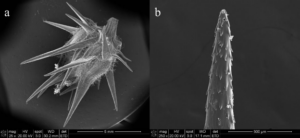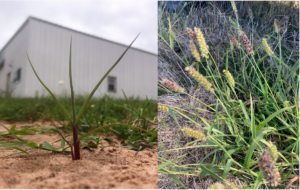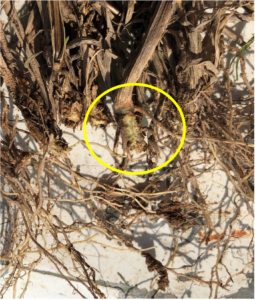February is the time for forage managers to begin waging war against this pest.
Many Cenchrus spp. go by grassburs, sandburs, stickerburs, or other names. This genus includes annual and perennial grasses that produce a pain-inflicting seed head. The burs that house the seed not only have spines but have fishhook-like barbs that grip what they have grabbed (Fig. 1).
There are three native species of sandburs in Texas that make up most infestations. These are also referred to as grassbur by many:
- field sandbur – Cenchrus spinifex
- longspine sandbur – Cenchrus longispinus
- southern sandbur – Cenchrus echinatus
Fig. 1. Scanning electron microscope image of sandbur: a) bur; b) close-up of a single spine.
(Photo credit: Erin Jenkins, Oklahoma State University, 2013.)
Field sandbur causes most of the problems in grass forages. Surveys across East Texas found all seed samples to be this species. This species is particularly problematic as it over-winters or perennializes. These perennials produce foliage earlier, more seeds, and will displace more forage than their annual counterparts.
Forages and turf sites are at risk for sandbur infestations in nearly every county in Texas. The first line of defense is ensuring no seed is introduced onto the landscape. These seeds will travel many miles on wildlife, vehicle tires, and will stick in equipment like hay rake tines, baling belts, and shredders.
One to three seeds in the sandbur pod will germinate once soil temperatures reach ~52°F and moisture is available. Germination ceases at about 74°F soil temperature. Many forage and turf managers experience two periods of germination, spring and fall, when soil temperatures are in this range. In my experience, the majority of seeds germinating in the growing season do so in the spring. In 7-13 weeks, a seed head forms (Fig. 2).
Fig. 2. Left, sandbur seedling; right, mature plant.
The next line of defense against this pest is healthy forage that is competitive. Whether in well-managed bermudagrass hayfields or lush grazed natives, many forage managers still encounter a steady growing sandbur population. The first step to wage war against these is knowing their location and if perennials are present.
Perennial identification is easiest in the winter months when the plant is dormant. Sandbur carcasses can be found, excavated, and the root area observed for green tissue once cut open (Fig 3). Pale green tissue indicates the potential perennial. If found, your management tactics will change once the growing season is underway.
Herbicide Options
Upon late winter for your area, forage managers can apply a pre-emergent herbicide with the active ingredient indaziflam. Working from South to North Texas, the beginning to the end of February is an ideal month for application. Though other products exist and can be effective, research across Texas points to this active ingredient performing the most consistent for forage settings.
February for Best Initial Control in Forages
In a perennial warm-season grass forage where no seeded annuals are present, the preferred program is 3 oz./acre of Rezilon applied in 15 gallons per acre of water minimum. After the first hay cutting or major grazing event where the forage canopy is low and open, another application at the same rate should be made. This will ensure enough residual to last through the fall germination period.
On-going Control in Forages
If seedlings are found (≤2”) after baling the first hay cutting or major grazing event, Pastora herbicide at 1 – 1.5 oz per acre included with the Rezilon application will be required for post control. If perennials have been identified, Pastora will only be expected to provide suppression to these and any plants larger than 2 inches. This product is only labeled for bermudagrass forages.
For larger plants and perennials, glyphosate at 0.4 lbs acid equivalency per acre is needed. This translates to 17 oz per acre of a 3 lbs acid equivalency per gallon (lb ae/gal), 12.8 oz per acre of a 4 lb ae/gal, and 11.4 oz per acre of a 4.5 lb ae/gal product. Forage injury may occur with glyphosate, but damage is likely to be transient if the application is made within 7-10 days of cutting.
For any post application, medium droplet size should be produced. This will ensure proper coverage of the slender leaves. Consult the product label to select the proper surfactant if required.
Additional Information
Additional information for forage managers can be found in the Grassbur/Sandbur Identification and Management in Pastures and Hayfields publication. For those managing turf, additional information can be found in the Grassbur/sandbur Management in Turf publication. For additional weed management information and contacts for weed related issues across Texas, visit our website.
Forage Herbicide Labels
Author: Zach Howard
Extension Program Specialist I, Weed Science


